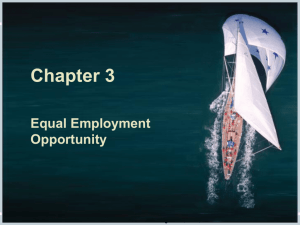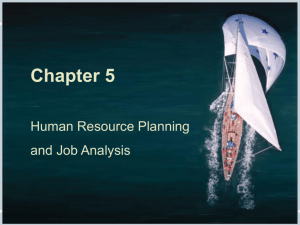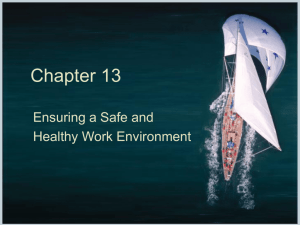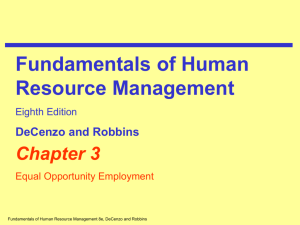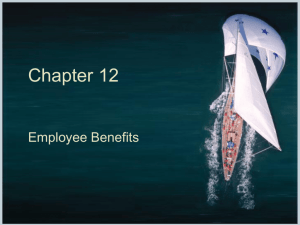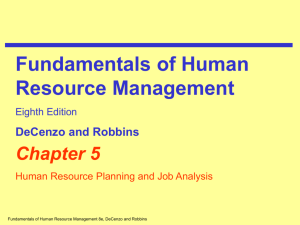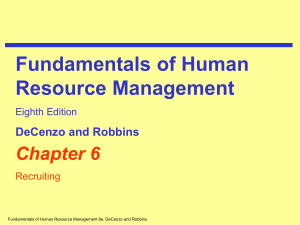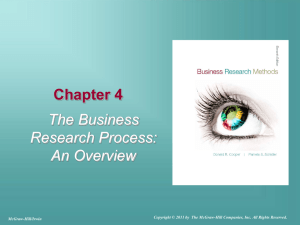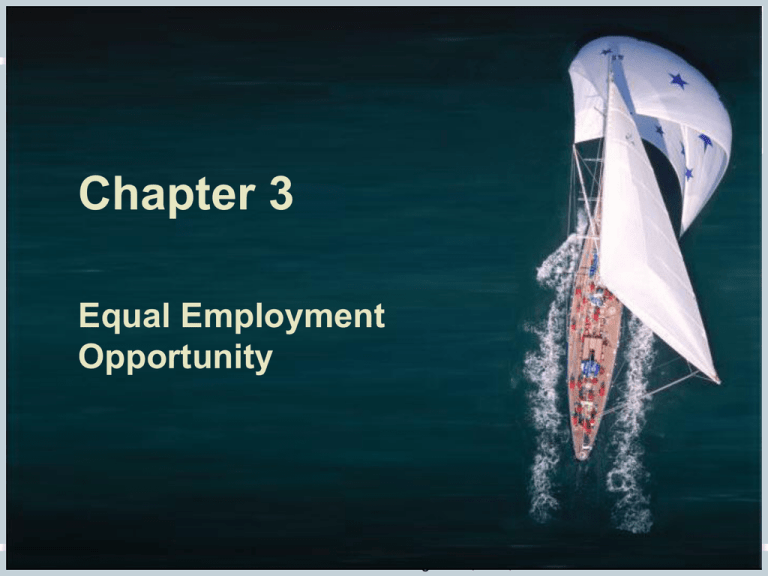
Chapter 3
Equal Employment
Opportunity
Fundamentals of Human Resource Management, 10/e, DeCenzo/Robbins
Introduction
Almost every U.S. organization, public and private,
must abide by
the 1964 Civil Rights Act
its 1972 amendment
other federal laws regulating employment
State and municipal laws may go beyond federal laws.
Fundamentals of Human Resource Management, 10/e, DeCenzo/Robbins
Laws Affecting Discriminatory Practices
The 1866 Civil Rights Act prohibited discrimination in
employment based on race and color.
White males have used it to argue reverse discrimination in court cases.
Fundamentals of Human Resource Management, 10/e, DeCenzo/Robbins
Laws Affecting Discriminatory Practices
The 1964 Civil Rights Act
outlawed racial segregation and discrimination in
employment, public facilities, and education
Title VII covers hiring, promotion, dismissal,
benefits, compensation or any other terms, conditions,
or privileges based on race, religion, color, gender, or
national origin
Organizations must have at least 15
employees to be covered.
Fundamentals of Human Resource Management, 10/e, DeCenzo/Robbins
Laws Affecting Discriminatory Practices
The 1972 Equal Employment Opportunity Act
(EEOA)
enforced the 1964 Civil Rights Act
established the Equal Employment Commission
(EEOC)
expanded scope of civil rights protection to
employees of state and local governments,
education, and labor
introduced affirmative action
Fundamentals of Human Resource Management, 10/e, DeCenzo/Robbins
Laws Affecting Discriminatory Practices
1967 Age Discrimination in Employment Act
(ADEA)
protects people over age 39
stopped companies from requiring mandatory
retirement at any age
uses four criteria to determine discrimination
whether:
1. the employee is part of a protected group
2. adverse employment action was taken
3. worker was replaced by a younger worker
4. worker was qualified for the job
Fundamentals of Human Resource Management, 10/e, DeCenzo/Robbins
Laws Affecting Discriminatory Practices
The Pregnancy Discrimination Act of 1978
Companies may not
fire a female employee for being pregnant
refuse positive treatment based on pregnancy
deny insurance coverage to women
Companies must
offer pregnancy leave (typically 6-10 weeks)
offer returning employee a similar job should the exact
one be unavailable upon return
Fundamentals of Human Resource Management, 10/e, DeCenzo/Robbins
Laws Affecting Discriminatory Practices
Americans with Disabilities Act (ADA) of 1990
extends protection and reasonable
accommodations to those with a disability
defines disabled as a person who:
1. has a physical or mental impairment that substantially limits
one or more life activities
2. has a history or record of such impairment
3. is perceived by others as having such impairment
Covers not only those with mobility and communication
disabilities, but those with HIV/AIDS and intellectual
disabilities.
Fundamentals of Human Resource Management, 10/e, DeCenzo/Robbins
Laws Affecting Discriminatory Practices
The Civil Rights Act of 1991
reinforced the 1964 Act, as a number of Supreme Court cases
over the years weakened it
included the Glass Ceiling Act and established the Glass
Ceiling Commission to study management practices
First time such an act allowed individuals to sue for
punitive damages.
Fundamentals of Human Resource Management, 10/e, DeCenzo/Robbins
Laws Affecting Discriminatory Practices
The Family and Medical Leave Act of 1993
allows employees to take up to 12 weeks of unpaid
leave in a 12-month period for family matters
employees must
1. live within a 75-mile radius
2. have worked at least 1,250 hours in the past 12 months
3. work for a company that employs at least 50 workers
FMLA difficulties for HR: defining conditions sufficient to take leave,
staffing problems that result, and timing of leave notification.
Fundamentals of Human Resource Management, 10/e, DeCenzo/Robbins
Laws Affecting Discriminatory Practices
USERRA and Executive Orders
Uniformed Services Employment and Reemployment Rights
Act of 1994 clarifies and strengthens rights of veterans
who served in the national guard or reserves
Executive Order 11246 prohibits discrimination by federal
agencies and contractors / subcontractors
Executive Order 11375 added sex-based criteria to 11246
Executive Order 11478 added that employment practices of
the federal government must be based on merit and
prohibit discrimination
Fundamentals of Human Resource Management, 10/e, DeCenzo/Robbins
Guarding Against Discrimination Practices
Four tests can determine if discrimination occurred:
geographical
comparisons
4/5ths rule
restricted
policy
McDonnell
Douglas test
But it is up to a judicial body to make the
final determination.
Fundamentals of Human Resource Management, 10/e, DeCenzo/Robbins
Guarding Against Discrimination Practices
4/5ths
rule
number of minority members hired must equal at least 80
percent (4/5ths) of the majority members in the population
hired
issued by the EEOC, it helps to assess if adverse impact has
occurred
Connecticut v. Teal (1984) case established that decisions in
each step of decision process must conform to the 4/5ths rule
Exhibit 3.3 shows an example of compliance and noncompliance with the 4/5ths rule.
Fundamentals of Human Resource Management, 10/e, DeCenzo/Robbins
Guarding Against Discrimination Practices
restricted
policy
Do HRM policies exclude a class of individuals?
geographical
comparisons
Does company’s mix of employees at all levels reflect its
recruiting market?
Fundamentals of Human Resource Management, 10/e, DeCenzo/Robbins
Guarding Against Discrimination Practices
McDonnell
Douglas
Test
Charge must meet four criteria:
1. the applicant is a member of a protected group
2. the applicant was qualified for job
3. the applicant was rejected
4. the organization, after rejecting applicant, continued to seek
other applicants with similar qualifications
Fundamentals of Human Resource Management, 10/e, DeCenzo/Robbins
Guarding Against Discrimination Practices
How companies can respond to discrimination
charges if found to have adverse impact:
discontinue the practice
defend against the charges by arguing:
1. business necessity
2. bona fide occupational qualification
3. seniority
Proving job relatedness is often the
most common approach.
Fundamentals of Human Resource Management, 10/e, DeCenzo/Robbins
Relevant Supreme Court Cases
HRM practices can be challenged by anyone, and HRM must be
able to defend its practices.
Fundamentals of Human Resource Management, 10/e, DeCenzo/Robbins
Enforcing Equal Opportunity Employment
EEOC
Enforces federal laws on civil rights at work.
www.eeoc.gov
Follows a five-step process:
1. EEOC notifies company within 10 days of filing and begins
investigation
2. EEOC notifies company of findings within 120 days
3. if unfounded, process stops; if founded, EEOC tries to resolve
4. if unsuccessful, EEOC begins mediation (settlement meeting)
5. if unsuccessful, EEOC may file charges in court
Has power to investigate claims but no enforcement power.
Fundamentals of Human Resource Management, 10/e, DeCenzo/Robbins
Issues in Employment Law
EEOC: Instances where verbal or physical
conduct creates:
sexual
harassment
an intimidating, offensive, or hostile environment
unreasonably interferes with an individual’s work
adversely affects an employee’s employment
opportunities
Glass ceiling - lack of women and minority
representation at the top levels of organizations
comparable
worth
OFCCP has glass ceiling initiative
promotes career development for women
and minorities
looks for such in its audits
Fundamentals of Human Resource Management, 10/e, DeCenzo/Robbins
HRM in a Global Environment
Laws affecting HRM vary greatly by country.
60/100-hour work-weeks not uncommon.
China’s recent labor laws seek to protect
employees from such practices
China
Canada
Canadian laws closely parallel those in the U.S.
Mexico
In Mexico, employees more likely to be unionized
Australia
Australia’s discrimination laws not enacted until the
1980s
Germany
Representative participation (work councils and board
representatives) put labor on par with management
and stockholders
Fundamentals of Human Resource Management, 10/e, DeCenzo/Robbins
Fill-in-the-blanks
1.The 1964 Civil Rights Act, Title VII, protects individuals on the basis of
____, _____, ________, ___, and ________ ______.
2. The Equal Opportunity Employment Act established the _________.
3. The Civil Rights Act of 1991 included the _____ _______ Act.
4. The 4/5ths Rule: number of minority members hired must equal at least
___ percent of the majority members in the population hired.
5. With _______ _________, companies argue job relatedness in
responding to accusations of discrimination in hiring.
6. The 1971 Supreme Court case _____v.________________ ruled that
tests must fairly measure the skills and knowledge required for a job.
7. The EEOC defines sexual harassment as creating an ____________.
Fundamentals of Human Resource Management, 10/e, DeCenzo/Robbins
1. The 1964 Civil Rights Act, Title VII, protects individuals on the basis of
____, _____, ________, ___, and ________ ______.
race, color, religion, sex, national origin
2. The Equal Opportunity Employment Act established the _________.
EEOC
3. The Civil Rights Act of 1991 included the _____ _______ Act.
Glass Ceiling
4. The 4/5ths Rule: number of minority members hired must equal at least
___ percent of the majority members in the population hired.
80
5. With _______ _________, companies argue job relatedness in responding
to accusations of discrimination in hiring.
Business necessity
6. The 1971 Supreme Court case _____v.________________ ruled that tests
must fairly measure the skills and knowledge required for a job.
Griggs v. Duke Power Company
7. The EEOC defines sexual harassment as creating an ____________.
intimidating, offensive, or hostile environment
Fundamentals of Human Resource Management, 10/e, DeCenzo/Robbins

